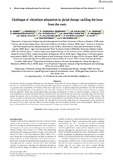Challenges of viticulture adaptation to global change: tackling the issue from the roots
Fecha
2021Autor
Versión
Acceso abierto / Sarbide irekia
Tipo
Artículo / Artikulua
Versión
Versión publicada / Argitaratu den bertsioa
Identificador del proyecto
MINECO//AGL2015-70931-REDT/ES/  AEI/Plan Estatal de Investigación Científica y Técnica y de Innovación 2013-2016/AGL2017-90759-REDT MINECO/Plan Estatal de Investigación Científica y Técnica y de Innovación 2017-2020/RYC-2017-22228 MINECO/Plan Estatal de Investigación Científica y Técnica y de Innovación 2017-2020/RYC-2017-23098
AEI/Plan Estatal de Investigación Científica y Técnica y de Innovación 2013-2016/AGL2017-90759-REDT MINECO/Plan Estatal de Investigación Científica y Técnica y de Innovación 2017-2020/RYC-2017-22228 MINECO/Plan Estatal de Investigación Científica y Técnica y de Innovación 2017-2020/RYC-2017-23098
 AEI/Plan Estatal de Investigación Científica y Técnica y de Innovación 2013-2016/AGL2017-90759-REDT MINECO/Plan Estatal de Investigación Científica y Técnica y de Innovación 2017-2020/RYC-2017-22228 MINECO/Plan Estatal de Investigación Científica y Técnica y de Innovación 2017-2020/RYC-2017-23098
AEI/Plan Estatal de Investigación Científica y Técnica y de Innovación 2013-2016/AGL2017-90759-REDT MINECO/Plan Estatal de Investigación Científica y Técnica y de Innovación 2017-2020/RYC-2017-22228 MINECO/Plan Estatal de Investigación Científica y Técnica y de Innovación 2017-2020/RYC-2017-23098 Impacto
|
|
10.1111/ajgw.12463
Resumen
Viticulture is facing emerging challenges not only because of the effect of climate change on yield and composition of grapes, but also of a social demand for environmental-friendly agricultural management. Adaptation to these challenges is essential to guarantee the sustainability of viticulture. The aim of this review is to present adaptation possibilities from the soil-hidden, and often disreg ...
[++]
Viticulture is facing emerging challenges not only because of the effect of climate change on yield and composition of grapes, but also of a social demand for environmental-friendly agricultural management. Adaptation to these challenges is essential to guarantee the sustainability of viticulture. The aim of this review is to present adaptation possibilities from the soil-hidden, and often disregarded, part of the grapevine, the roots. The complexity of soil-root interactions makes necessary a comprehensive approach taking into account physiology, pathology and genetics, in order to outline strategies to improve viticulture adaptation to current and future threats. Rootstocks are the link between soil and scion in grafted crops, and they have played an essential role in viticulture since the introduction of phylloxera into Europe at the end of the 19th century. This review outlines current and future challenges that are threatening the sustainability of the wine sector and the relevant role that rootstocks can play to face these threats. We describe how rootstocks along with soil management can be exploited as an essential tool to deal with the effects of climate change and of emerging soil-borne pests and pathogens. Moreover, we discuss the possibilities and limitations of diverse genetic strategies for rootstock breeding. [--]
Materias
Climate change,
Genetics,
Rootstock,
Sustainability,
Vitis
Editor
Wiley
Publicado en
Australian Journal of Grape and Wine Research 27,8–25, 2021
Departamento
Universidad Pública de Navarra. Departamento de Agronomía, Biotecnología y Alimentación /
Nafarroako Unibertsitate Publikoa. Agronomia, Bioteknologia eta Elikadura Saila
Versión del editor
Entidades Financiadoras
This work is framed in the networking activities of RedVitis (AGL2015-70931-REDT) and RedVitis 2.0 (AGL2017-90759-REDT), funded by the State Research Agency (AEI) of the Spanish Ministry of Science and Innovation. Ms Diana Marin is beneficiary of postgraduate scholarship funded by Universidad Publica de Navarra (FPI-UPNA-2016). Dr Juan Emilio Palomares-Rius acknowledges the State Research Agency (AEI) of the Spanish Ministry of Science and Innovation for the 'Ramon y Cajal' Fellowship RYC-2017-22228 and Dr David Gramaje acknowledges Spanish Ministry of Economy and Competitiveness for the 'Ramon y Cajal' Fellowship RYC-2017-23098.
Aparece en las colecciones
Los documentos de Academica-e están protegidos por derechos de autor con todos los derechos reservados, a no ser que se indique lo contrario.
La licencia del ítem se describe como © 2020 The Authors. This is an open access article under the terms of the Creative Commons Attribution-NonCommercial-NoDerivs License, which permits use and distribution in any medium, provided the original work is properly cited, the use is non-commercial and no modifications or adaptations are made.






